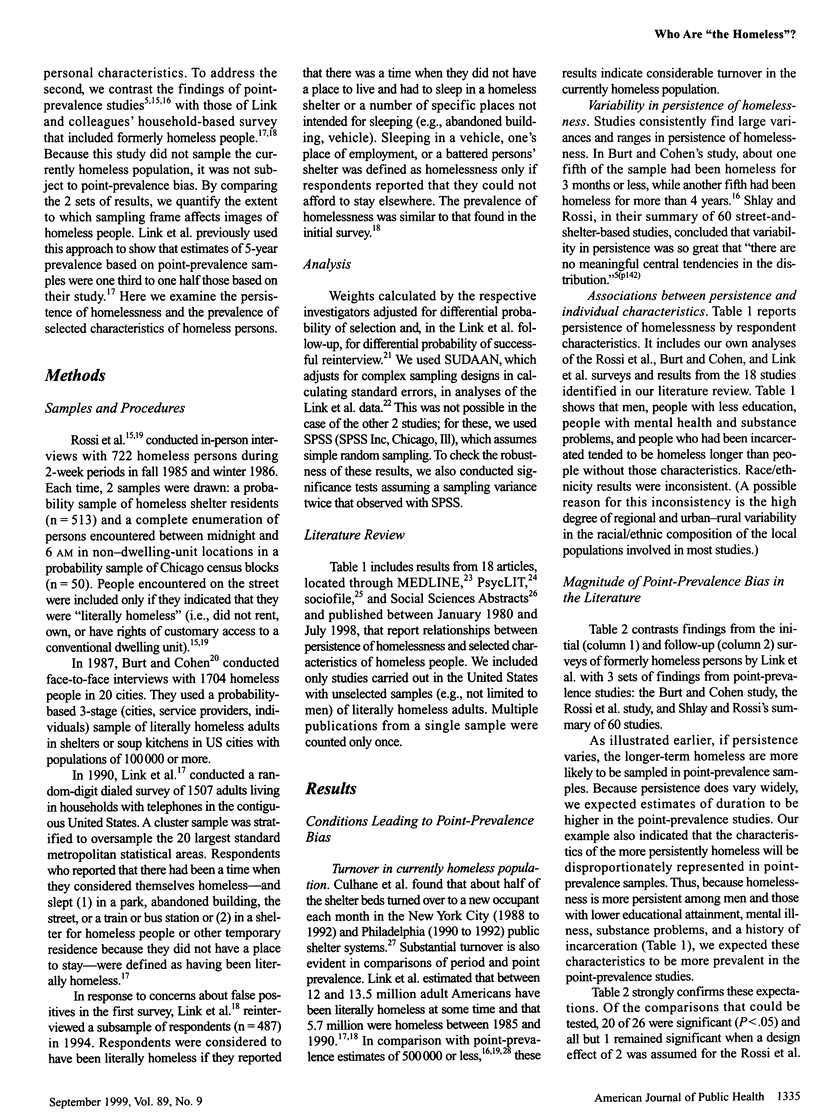Abstract
OBJECTIVES: This study assessed the extent to which the use of point-prevalence samples biases conclusions drawn about homeless people. METHODS: Three data sets and published research were used to examine the degree to which conditions leading to point-prevalence bias (turnover in the homeless population, variability in the persistence of homelessness, and associations between personal characteristics and persistence) characterize the homeless population. Results were compared from point-prevalence studies concerning persistence of homelessness and characteristics of homeless people with those from a study of formerly homeless people. RESULTS: Conditions leading to point-prevalence bias strongly characterize the homeless population. Moreover, profiles of homeless people differed dramatically between point-prevalence studies and the study of formerly homeless people. In the former, average duration of homelessness was longer, and samples included higher proportions of men, minorities, non-high school graduates, and people with histories of psychiatric hospitalization, incarceration, and detoxification. CONCLUSIONS: Reliance on point-prevalence samples, when such samples are generalized beyond the currently homeless population, leads to overestimations of the persistence of homelessness, the demographic distinctiveness of the homeless population, and the prevalence of personal disabilities and deviant lifestyles among homeless people.
Full text
PDF




Selected References
These references are in PubMed. This may not be the complete list of references from this article.
- Cohen P., Cohen J. The clinician's illusion. Arch Gen Psychiatry. 1984 Dec;41(12):1178–1182. doi: 10.1001/archpsyc.1984.01790230064010. [DOI] [PubMed] [Google Scholar]
- Fischer P. J., Breakey W. R. The epidemiology of alcohol, drug, and mental disorders among homeless persons. Am Psychol. 1991 Nov;46(11):1115–1128. doi: 10.1037//0003-066x.46.11.1115. [DOI] [PubMed] [Google Scholar]
- Gelberg L., Linn L. S. Assessing the physical health of homeless adults. JAMA. 1989 Oct 13;262(14):1973–1979. [PubMed] [Google Scholar]
- Link B. G., Susser E., Stueve A., Phelan J., Moore R. E., Struening E. Lifetime and five-year prevalence of homelessness in the United States. Am J Public Health. 1994 Dec;84(12):1907–1912. doi: 10.2105/ajph.84.12.1907. [DOI] [PMC free article] [PubMed] [Google Scholar]
- Link B., Phelan J., Bresnahan M., Stueve A., Moore R., Susser E. Lifetime and five-year prevalence of homelessness in the United States: new evidence on an old debate. Am J Orthopsychiatry. 1995 Jul;65(3):347–354. doi: 10.1037/h0079653. [DOI] [PubMed] [Google Scholar]
- Rosenheck R., Fontana A. A model of homelessness among male veterans of the Vietnam War generation. Am J Psychiatry. 1994 Mar;151(3):421–427. doi: 10.1176/ajp.151.3.421. [DOI] [PubMed] [Google Scholar]
- Shinn M. Homelessness: what is a psychologist to do? Am J Community Psychol. 1992 Feb;20(1):1–24. doi: 10.1007/BF00942179. [DOI] [PubMed] [Google Scholar]
- Shinn M., Weitzman B. C., Stojanovic D., Knickman J. R., Jiménez L., Duchon L., James S., Krantz D. H. Predictors of homelessness among families in New York City: from shelter request to housing stability. Am J Public Health. 1998 Nov;88(11):1651–1657. doi: 10.2105/ajph.88.11.1651. [DOI] [PMC free article] [PubMed] [Google Scholar]
- Susser E., Moore R., Link B. Risk factors for homelessness. Epidemiol Rev. 1993;15(2):546–556. doi: 10.1093/oxfordjournals.epirev.a036133. [DOI] [PubMed] [Google Scholar]
- Susser E., Struening E. L., Conover S. Psychiatric problems in homeless men. Lifetime psychosis, substance use, and current distress in new arrivals at New York City shelters. Arch Gen Psychiatry. 1989 Sep;46(9):845–850. doi: 10.1001/archpsyc.1989.01810090087012. [DOI] [PubMed] [Google Scholar]
- Susser E., Valencia E., Conover S. Prevalence of HIV infection among psychiatric patients in a New York City men's shelter. Am J Public Health. 1993 Apr;83(4):568–570. doi: 10.2105/ajph.83.4.568. [DOI] [PMC free article] [PubMed] [Google Scholar]
- Wallace R., Wallace D. The coming crisis of public health in the suburbs. Milbank Q. 1993;71(4):543–574. [PubMed] [Google Scholar]


